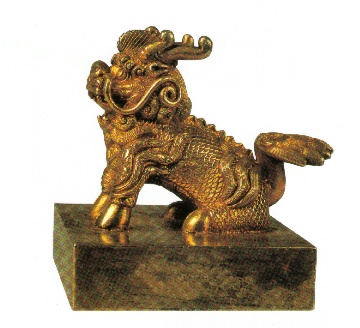|
|
|
Is there a Chinese alphabet?
No! Chinese uses characters
like this to communicate in writing:
Each character stands for a word. Sometimes, characters are combined to create new words.
The word Calligraphy means 'good' 'writing'. Chinese calligraphy is an art form, and calligraphers are highly respected. There are several different styles of Chinese writing used today:
Like a painter, the calligrapher can express his thoughts and feelings by choosing a certain calligraphy style to write the characters, The same tools (brush, ink, silk, and paper) are used for both writing and painting.1. Seal (Zhuan Shu)
2. Official or clerical (Li Shu)
3. Regular (Kai Shu)
4. Running or semi-cursive (Cao Shu)
5. Cursive.
There are also many styles that are no longer used (like the Jia Gu Wen style in the chart below.) This chart compares some of the styles of calligraphy. It shows how you would write the word (in English on the left) in 5 different Calligraphy styles.
Calligraphy is an art dating back to the earliest days of history, and is widely practiced throughout China to this day. Although each symbol means a word in Chinese, you do not have to know Chinese to appreciate its beauty.
How Many Chinese words are there?
No one knows for sure! High school students
learn less than 1,000 words. A college student probably has a vacabulary
of some 4,000 words. Good newspapers use perhaps 2,000 words. Some
researchers have guessed that over 50,000 words exist in all the different
writing styles.
You must know how to hold the brush correctly
to become a good calligrapher. Calligraphy takes lots of practice.
This
is how you hold the brush - straight up and down.
Love
Luck
Peace
Eternity
Friendship
Unity
Work
Together!
Chinese Seals

Why are there red stamps all over this painting?
These red stamps, called seals,
are the impressions made from stones and other materials that have first
been pressed into red seal paste. Here are some examples of seals and the
imprints that they make:

Seals show the artist's name, and also might show a history of all of the owners of a painting because each owner would add their seal to a painting when they bought it. Since artists and writers usually used several different names throughout their lives, they had many seals made with their family names, artistic names, the names of their studios, or maybe evan a seal that had one of their favorite sayings on it.
The seals are not meant to distract the viewer from the picture, but instead give honor and value to the work of art. Artists carefully plan where they will place each seal to complement the picture. Owners also carefully placed their seal impressions. The seals of well-known artists, critics, and personalities from the past on a painting give a little history about each work of art.
Usually rectangular or round, seal designs
are carved into materials such as jade, ivory, and soapstone.
Often the top of the seal was carved into
a little sculpture.  Some
of the sculptures were very fancy!
Some
of the sculptures were very fancy!
The red square on the left is the image on
the paper that was left behind when the seal was pressed into red seal
paste and printed.

In Art Class, you are going to make your own seal to use on your artwork. For this you will need to get your name translated into Chinese characters! The website that does this uses the sounds in your name and finds the Chinese sounds that match. Follow the directions on the website, and don't forget to print out your name when you get it!
To get your Chinese name, click here.
To return to the Webquest Page, click here.
To return to the Arts in China Home Page,
click here.